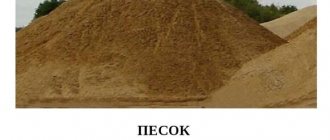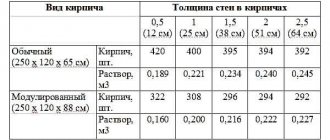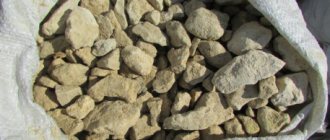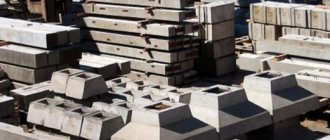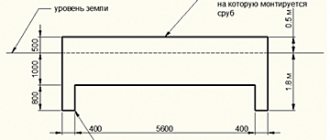An important calculated value is the weight of construction waste. If you do not know how much the resulting debris weighs, it is difficult to order waste collection containers of a suitable size. They are guided by weight when choosing a vehicle for transporting waste with the appropriate carrying capacity, and calculate the number of trips to the waste processing complex. This allows you to calculate the cost of the work and include the amount in the estimate documentation.
In addition to the weight of construction waste, the choice of transport and containers, as well as the cost of work, is influenced by other parameters - volume, density, specific gravity and other quantities.
What is the density of construction waste
The density of construction waste is one of the main indicators when calculating the cost of waste removal services. A common physical quantity denotes the ratio of the mass of a body (in our case, garbage) and its volume.
For example, polyurethane foam has a much lower density than concrete. If one container is completely filled with foam, and concrete is placed in the second container, then with the same volume the mass of the containers will differ.
Knowledge of the density of construction waste has direct practical application. Each vehicle has its own set carrying capacity.
If 5 cubic meters of wood can be placed in one vehicle, then several such trucks will be required to move a concrete mixture of the same volume.
The more accurately the weight and volume of construction waste is calculated, the easier it is to choose transport with the appropriate cargo parameters. This will save thousands of rubles both during construction and during dismantling of the facility.
Density is a physical quantity that is part of the formula for calculating the mass and volume of garbage. All three parameters are involved in the calculations of logistics schemes. In particular, specialists decide how many trucks to use, how many trips will have to be made per shift to meet the schedule, and which containers will cope with the announced volume of work.
In the construction industry, the professional term most often used is bulk density. If in the “original” density is a characteristic of a solid substance, then in the second case it takes into account the voids that form between waste particles. For example, granite and crushed granite, despite having a similar composition, have different densities:
- Granite is a hard material with a density of 2.6 tons/m3;
- Granite crushed stone is its bulk derivative with a bulk density of 1.4 tons/m3.
The density of materials in different reference books may vary. In order for the calculation results to be the same, the concept of average density of construction waste was introduced into use.
Here are examples of the average volumetric mass of the most common types of construction waste:
| An object | Volumetric mass*, (kg /m3) |
| Dismantling of concrete structures | 2400,0 |
| Dismantling of reinforced concrete structures | 2500,0 |
| Dismantling of brick and stone structures, broken plaster, tiles | 1800,0 |
| Dismantling of wooden, frame-fill objects | 600,0 |
| Other work on dismantling structures (with the exception of metal structures, engineering equipment**) | 1200,0 |
| (*) volumetric mass is indicated taking into account the dense body of structures (**) values are taken according to the information specified in the project documentation | — |
The bulk density of waste is below the values given in the table:
| Dismantled material | Bulk density, (kg /m3) |
| Mixed waste (dismantling) | 1600,0 |
| Mixed waste (residues after repairs) | 160,0 |
| Asbestos (pieces) | 700,0 |
| Brick fight | 1900,0 |
| Ceramics (products) | 1700,0 |
| Sand | 1650,0 |
| Asphalt (removed road surface) | 1100,0 |
| Mineral wool insulation | 200,0 |
| Steel products | 800,0 |
| Cast iron products | 1800,0 |
| Plaster | 1800,0 |
| Crushed stone | 2000,0 |
| Fibreboard, chipboard | 650,0 |
| Remains of wooden window frames, baseboards, panels, door frames | 600,0 |
| Pieces of linoleum | 1800,0 |
| Pieces of roofing felt | 600,0 |
Table of specific and volumetric gravity by type of waste
In reference books and construction documentation, two calculated characteristics of materials are often used - specific gravity and volumetric gravity.
Specific gravity (N/m³) is the ratio of the weight of a material to its volume. Specific gravity is calculated using the formula:
T x 9.8 m/s2 /V.
An example of calculating the specific gravity of waste with a volume of 4 m3 and weighing 1000 kg:
1000 x 9.8 m/s2/ 4 m3 = 2450 (N/m³)
In ordinary life, a person does not feel the difference between the mass and weight of an object or materials. We are used to saying, for example, “my weight is *** kg.” When calculations are made in construction and other areas of economics, physical quantities such as weight and mass are used according to the rules. Quantities are measured in different units - mass is written in grams/kilograms. Weight is most often measured in Newtons (N). Other systems use their own designations:
- In GHS it is dyne/cm3;
- In SI – N/m3;
- In MKSS – kg/m3.
To convert weight from one measurement system to another, use the following ratio:
1 N/m3=0.102 kg/m3=0.1 dyne/cm3
Sometimes construction waste can have the same density and specific gravity. In such cases, the corresponding parameters should be correctly designated - N/m3 or kg/m3.
Volumetric weight in some sources is called overall weight. This is the physical value of the density of the load. That phenomenon that was mentioned earlier is when waste with a lower density can take up more space than denser types of waste.
Volumetric weight is close to actual weight. In accompanying and transport documents, the parameter that is larger is usually indicated.
Formula for calculating volumetric weight:
(W x D x H)/ 5000
The table shows the specific and volumetric gravity of common types of waste (gravity is not taken into account):
| Type of waste | Specific weight (cub.m/t), average value | Volumetric weight (t/cub.m), average value |
| Construction | 0,83 | 1,2 |
| Street, household | 1,82 | 0,55 |
| Wood scraps | 2,86/1,82 | 0,4 |
| Remnants of fabric | 2,86 | 0,35 |
| Sawdust | 4,0 | 0,25 |
| Wet snow | 1,25 | 0,8 |
| Moistened snow | 2,22 | 0,45 |
| Dry snow | 8,33 | 0,12 |
| Slag (in the boiler room) | 1,33 | 0,75 |
| Crushed stone (brick) | 0,79 | 1,27 |
| Chips (wood) | 4,0 | 0,25 |
| Electrical fittings | 2,0 | 0,50 |
| Tar, asphalt | 0,77 | 1,3 |
| Broken glass, earthenware | 0,40 | 2,5 |
| Paper in rolls | 2,0 | 0,5 |
| Waste paper in bales | 1,43 | 0,7 |
| Bound waste paper | 1,82 | 0,55 |
| Pressed waste paper | 1,89 | 0,53 |
| Bottles | 2,50 | 0,4 |
| Rags in bales | 5,56 | 0,18 |
| Unwrapped plastic | 2,0 | 0,5 |
| Non-sheet glass (any products) | 3,85/2,00 | 0,4 |
| Cardboard in bales | 1,43 | 0,7 |
| Knitted cardboard | 2,33 | 0,43 |
| Scrap metal (cast iron, copper, steel, brass) | 0,48 | 2,1 |
| Aluminum scrap | 1,43 | 0,7 |
| Household scrap (oversized) | 2,5 | 0,4 |
| Machine elements | 3,0 | 0,5 |
| Furniture | 3,33 | 0,3 |
Data from reference books is used as a basis when calculating the weight, volume of construction and other waste. In the future, the values help plan the costs of loading and transportation. Many construction sites have implemented a special online calculator for calculating parameters. The client just needs to insert the values into the forms and receive a ready answer within a few seconds.
Physical properties of gravel
Gravel is considered a loose, granular rock. According to the predominant particle size, it is divided into several fractions: from 1 to 3 mm, from 3 to 5 mm, from 5 to 10 mm, 1 – 2 cm, 2 – 4 cm, 4 – 7 cm.
The frost resistance indicator is determined by the number of freezing-thaw cycles during which the particles do not change significantly. There can be from 15 to 300 such cycles.
The ability to absorb water depends on porosity: the higher it is, the greater this ability. The most porous is expanded clay - a material that looks similar to gravel, but is obtained by firing clay artificially.
The thermal conductivity of gravel determines its ability to retain heat. On average it is 0.93 W/m2.
Gravel Density
This indicator is especially important in road construction, where embankments made from this bulk material are used. It is also important for those who decide to purchase it to build their own home.
Humidity also affects the density of gravel. Heavily moistened material will have greater mass than dry material.
Determining the density of a material with known values of mass and volume is not difficult.
How is the weight of waste during dismantling calculated?
As a result of dismantling the structure, a huge amount of waste is generated. It is difficult to calculate the approximate volume. However, taking into account existing algorithms and formulas, it is possible to obtain the result. Follow the following pattern:
- Calculate the volume of the entire building: this is not an easy task, but it can be done. It is necessary to multiply the length, width, height of all parts of the building structure, including walls, roofing, foundation;
- Multiply the resulting value by the loosening coefficient - it is equal to 2;
- Multiply the mass of waste by the density (see the table).
The algorithm will allow you to obtain the weight of the removed construction waste. Using it, you will calculate the required number of containers of a certain volume and determine how many vehicles need to be used to remove waste to the landfill.
Example:
The garage is being dismantled. Volume of components:
- Roofing coverings – 21.38 m2;
- Brick walls – 99.85 m3;
- Reinforced concrete foundation 20.16 m3;
- Metal gates 9 m2.
The values of the specific and volumetric weight of 1 m3 of construction waste are displayed in the table:
| Type of waste | y /v | Quantity | o /v | Weight in 1 m3 |
| Ruberoid | 0.0078 tons per m2 | 21.38 m2 | 0.167 tons | 1600, |
| Brick (fight) | 1.8 tons per m3 | 99.85 m3 | 179.73 tons | 1800,0 |
| Reinforced concrete | 2.36 tons per m3 | 20.16 m3 | 47.58 tons | 2360,0 |
| Ferrous metal (scrap) | 23.55 kg per m2 | 9 m2 | 0.211 tons | 400,0-500,0 |
Result: the garbage generated during the dismantling of the garage weighs 227.688 tons.
Containers are used to remove construction waste in small quantities. Heavy residues are transported by heavy vehicles and dump trucks.
Calculation of waste weight during construction
During construction, waste is also generated. The waste includes the same construction and finishing materials, or rather, their unused remains and defects. The weight and volume of waste generated during the construction of structures is calculated using special techniques. For example, RDS 82-202-96 provides “RULES for the development and application of standards for difficult to eliminate losses and waste of materials in construction”:
| Materials, type of work | Waste generation during operation (%) |
| Building bricks (simple or medium design) | 1,0-1,5 |
| Construction brick (complex design) | 2,0 |
| Cement mortar | 2,0 |
| Leveling mortar (used when laying reinforced concrete structures and leveling them) | 4,0 |
| Timber | 3,0 |
| Formwork for reinforced concrete structures 0.3 m high | 4,0 |
| Formwork for reinforced concrete columns with P= 1.2 m | 6,0 |
| Formwork for partitions, walls | 1.5 |
A more detailed list of standards and values is indicated in another document - “On Reference Materials on Specific Indicators of the Formation of the Most Important Types of Industrial and Consumption Wastes” (1997 edition).
Example:
The object under construction is a brick garage.
4,000 bricks will be required. Each weight is 2.5 kg. According to the table, approximately 200 kilograms of brick waste are generated during construction:
1000 X 0.02 = 200.0 kg
Roofing: percentage of waste generated is 3.0
The percentage of roofing felt waste generated during roofing is 3%. It is estimated that to cover a garage you will need 6 rolls of roofing felt, sheets 1.0 by 10.0 m, with an average weight of each 27 kilograms. We count:
162 X 0.03 = 4.86 kilograms of roofing felt waste
Similarly, we calculate the amount of waste for cement, formwork, and metal structures.
Main areas of use
The high demand for broken bricks is due to a number of factors, which include the high cost of crushed stone and other aggregates, as well as the quality characteristics of the original product. These are: strength, frost resistance, heat and sound insulation. Based on the listed qualities, scrap brick is used for the following types of work:
- filling of dirt roads, as well as temporary entrances to construction sites;
The road to a remote village is paved with broken bricks - quickly, reliably and economically, but not all drivers will be able to drive along it yet
- decorative filling of the base of paths, decoration of flower beds, alpine slides;
- filling tennis courts with brick chips - the so-called tennisite;
Tennisite also contains sand and powdered clay.
- filling artificial excavations, including wells, trenches or pits, as well as gaps between the foundation and the ground;
- improving sound insulation characteristics, especially in buildings where there are wooden floors between floors;
- preparing concrete for the foundation, scrap bricks are used as filler;
- improving the thermal insulation of walls;
- soil strengthening on slopes;
- construction of a drainage layer in wetlands.
The only requirement for brick waste used as a building material is that it must be pre-cleaned for strong bonding with masonry mortar.
Calculation of concrete composition
Traditionally, concrete calculations mean calculating the percentage of the components of the resulting mixture in relation to each other. However, this calculation method is advisable if you plan to obtain a concrete mixture in small quantities.
When it is necessary to mix a solution in a large volume, the calculation is made by the weight of each component, which is selected in such a way that the finished concrete receives the necessary characteristics.
Thus, there are 2 ways to calculate the components of a concrete mixture:
First: according to the ratio of materials included in the composition. The calculation is carried out according to a simple formula:
1: X: Y: Z, where cement is taken as a “unit”, and water and sand are leveled over it.
Example:
- Cement 250 kg;
- Sand – 550 kg
- Crushed stone – 1050 kg
- Water – 150 l
When calculating, the weight of dry material is taken as a basis. To obtain the nominal composition, the formula includes the values multiplied by the required coefficient “1: X1: Y1”
When producing a small volume of concrete mixture, ready-made tables are often used indicating the amount of each component in the composition. When breeding a batch, a small batch is mixed and a prototype is tested.
Another way to prepare and check the quality of concrete is when the mixture is produced in large quantities, or it is used to create a finished concrete structure. In such cases, quality is determined empirically. Special experimental batches are being carried out.
To get a high-quality concrete mixture, follow a few simple rules:
- Use concrete of the grade that, after hardening, will gain the required design strength;
- Choose the right type and brand of binder;
- Pay attention to the characteristics of the filler: grain size, specific and volumetric weight, voidness;
- Consider such characteristics as workability and mobility of the concrete mixture.
Concrete calculations are carried out according to the following scheme:
- Determine the ratio of components (using the formula, or take the values in the finished table);
- Determine how much water is required during pre-mixing. The values are taken from the corresponding table. There are two of them - to obtain a plastic and rigid mixture;
- Multiply the obtained indicators: B x C/V = X (kg/cub.m.);
- Check the composition of the concrete by performing 3 test batches of 7-15 liters each. Moreover, in the first batch the W/C must correspond to the calculated parameter, in the second the value should be 20% higher, and in the third it should be 20% lower than the calculated parameter.
Prices for broken bricks
Prices for scrap bricks, as for many types of scrap, depend on the quality, composition of the scrap, and volume. The average price is 200 rubles per ton .
Some set the price for broken bricks in cubic meters - the average price is the same 200 rubles per ton . It all depends on the size of the scrap, and in each specific batch there may be more than a ton of brick in one cube, and less than a ton in another cube - this point is also worth taking into account if costs are tied to weight.
There are more offers on the market for selling than for buying broken bricks. And here the following picture emerges: sellers strive to sell as expensively as possible, and buyers strive to buy as cheaply as possible (as in any area of the market, however). And it turns out that the selling price is 400 rubles per ton , and the purchase price is 100 rubles per ton .
Naturally, we are talking about such a fight as in the photo - not crushed into fractions and not about a finished product, such as tennisite (brick chips).
Scrap bricks for sale - good quality scrap in the photo
How to convert construction weight from tons to m3
To convert the weight of construction waste from tons to a volume unit (number of cubic meters), use a table with data on the average density of materials.
For example, let's take asphalt. The volumetric weight of 1 cubic meter of material is 1300 kg/m3. We need to find out the weight of the waste generated during the dismantling of the coating and divide the value by the average density of one cubic meter. We get:
With a waste weight of 5 tons, the calculation will be as follows: 5000: 1300 = 3.84 m3
The scope of scrap directly depends on the type of original product
The next important parameter for categorizing brick waste is the grade of the primary product, as well as its type. Most people divide brick into two types: red and white. This has its reason, since red varieties are made primarily from clay, while white is produced using a mixture of sand and limestone.
Interesting video - modern brick production:
In fact, there are many varieties of bricks, but in terms of scrap, the following categories can be distinguished:
- Refractory materials (see refractory scrap ). This group includes fireclay, magnesia, carbon and quartz bricks; their destruction, as a rule, is sold separately.
- Silicate. The material is characterized by low water resistance, which limits the scope of use of white brick waste.
- Ceramic. It is made from clay of the same mineral composition. When using waste ceramic bricks, you should take into account its demands on the quality of the masonry mortar.
- Finishing. The breakage of this brick is not in great demand.
Along with the specific type, there is a sorting of bricks by quality. This should also be taken into account when using combat.
Thus, the manufacturing technology of red brick provides for three grades, which affects both the properties of the product itself and its scrap. For example, waste from the original third-grade product will have low adhesion to mortars. Their use is more appropriate for compacting soil or filling up uneven terrain. Second-grade red brick is highly hygroscopic, which reduces its water resistance. First-class products, even being scrap, turn out to be universal in terms of scope, and brick waste has quite a wide range of applications.
White brick fight
Weight of 1 m3 of construction waste
It’s easier and faster to find out the weight of one volumetric unit of construction waste if you have an online calculator at hand. Such functionalities are created using special programs that take into account all the necessary data to obtain the required value.
Services for calculating the volume of construction waste in any unit of measurement are also provided by specialized companies that deal with the removal and disposal of waste, including construction waste generated during the construction of buildings and during dismantling. Based on the calculations performed, the manager will offer the required number of units of special equipment and containers of the required volume.
If you have the necessary tables with values and experience in making calculations, you can find out the weight of 1 cubic meter of construction waste yourself. To do this, substitute the known parameters into the formula:
m = p x V, where:
m – mass of waste;
p – density of construction waste;
V – volume of waste.
You can also use a special table with average coefficients that are relevant for different materials. As a rule, the average weight of construction waste lies in the range of 0.15 - 0.65 tons.
You may be interested in:
Dilapidated furniture Metal doors From the apartment with movers Removal of solid waste Waste paper From cafes and restaurants
Scrap bricks for free?
It also happens that a large construction organization purchases territories for the construction of large multi-storey buildings - entire blocks. There are buildings on this territory that urgently need to be dismantled and removed. In this case, there are contractors who are engaged in dismantling under the contract and, in order not to go beyond the deadlines and not to violate the contract, they have to get rid of construction scrap, reinforced concrete and broken bricks, giving it away for free , because There is no time to sell, and not everyone will find it profitable to take it to another site.
There are such cases, many dismantlers, for example, those who dismantle metal structures, will not look for buyers for scrap bricks (if such scrap appears during the process) - it is easier for them to place an advertisement on the MARKET.XLOM.RU board or Avito with the following content: “we will give away the scrap free bricks, pick up.”
Therefore, before buying such scrap, you should spend a couple of hours searching for offers for free scrap bricks, and taking it out will not be a problem.
Very often, the dismantling of metal structures is accompanied by the dismantling of buildings and structures (and vice versa)
What affects the cost of removing construction waste?
The weight of construction waste is the main, but not the only parameter that affects the cost of waste removal services from the site. The final price consists of several factors. The cost components are:
- Option for laying on a vehicle – vertically or horizontally;
- Distance from the dismantling site to the storage area: it is not always possible to install containers next to a pile of garbage, and sometimes there are no access roads that would allow the dump truck to be brought directly to the loading terminal;
- Putting waste into bags;
- Remuneration of employees.
The final cost of removing construction waste will be determined by waste management company specialists.
